I see that your model might be improved in consistency, state control, and scaling.
A way of to implement this is accouple the item to your state, enqueue and dequeue this couple and create a mechanism to ensure state change.
My proposal can be see in figure below:

According with this model and your example, we can to do:
package stackoverflow;
import java.util.concurrent.LinkedBlockingQueue;
import stackoverflow.item.ItemState;
import stackoverflow.task.CreatingTask;
import stackoverflow.task.FirstMovingTask;
import stackoverflow.task.SecondMovingTask;
public class Main {
private static void startTask(String name, Runnable r){
Thread t = new Thread(r, name);
t.start();
}
public static void main(String[] args) {
//create queues
LinkedBlockingQueue<ItemState> firstQueue = new LinkedBlockingQueue<ItemState>();
LinkedBlockingQueue<ItemState> secondQueue = new LinkedBlockingQueue<ItemState>();
//start three threads
startTask("Thread#1", new CreatingTask(firstQueue));
startTask("Thread#2", new FirstMovingTask(firstQueue, secondQueue));
startTask("Thread#3", new SecondMovingTask(secondQueue));
}
}
Each task runs the operations op() of according with below affirmation on ItemState:
one of three dedicated thread moves it to secondQueue and finally
another dedicated thread removes it.
ItemState is a immutable object that contains Item and your State. This ensures consistency between Item and State values.
ItemState has acknowledgement about the next state creating a mechanism of self-controled state:
public class FirstMovingTask {
//others codes
protected void op() {
try {
//dequeue
ItemState is0 = new ItemState(firstQueue.take());
System.out.println("Item " + is0.getItem().getValue() + ": " + is0.getState().getValue());
//process here
//enqueue
ItemState is1 = new ItemState(is0);
secondQueue.add(is1);
System.out.println("Item " + is1.getItem().getValue() + ": " + is1.getState().getValue());
} catch (InterruptedException e) {
e.printStackTrace();
}
}
//others codes
}
With ItemState implemetation:
public class ItemStateImpl implements ItemState {
private final Item item;
private final State state;
public ItemStateImpl(Item i){
this.item = i;
this.state = new State();
}
public ItemStateImpl(ItemState is) {
this.item = is.getItem();
this.state = is.getState().next();
}
// gets attrs
}
So this way is possible build solutions more elegant, flexible and scalable.
Scalable because you can to control more states only changing next() and generalizing the moving task for increase the number of queue.
Results:
Item 0: AFTER_FIRST
Item 0: IN_FIRST
Item 0: IN_SECOND
Item 0: AFTER_SECOND
Item 1: IN_FIRST
Item 1: AFTER_FIRST
Item 1: IN_SECOND
Item 1: AFTER_SECOND
Item 2: IN_FIRST
Item 2: AFTER_FIRST
Item 2: IN_SECOND
... others
UPDATE(06/07/2018): analysing the use of map for search
Search in map using equals values like comparator might not work because usally the mapping between values and identity (key/hash) is not one-to-one(see figure bellow). In this way is need to create an sorted list for search values which results in O(n) (worst-case).

with Item.getValuesHashCode():
private int getValuesHashCode(){
return new HashCodeBuilder().append(value).hashCode();
}
In this case, you must keep Vector<ItemState> instead of Item and to use the key like the result of getValuesHashCode. Change the mechanism of state-control for keep first reference of the Item and the state current. See bellow:
//Main.class
public static void main(String[] args) {
... others code ...
//references repository
ConcurrentHashMap<Integer, Vector<ItemState>> statesMap = new ConcurrentHashMap<Integer, Vector<ItemState>>();
//start three threads
startTask("Thread#1", new CreatingTask(firstQueue, statesMap));
... others code ...
}
//CreateTask.class
protected void op() throws InterruptedException {
//create item
ItemState is = new ItemStateImpl(new Item(i++, NameGenerator.name()));
//put in monitor and enqueue
int key = is.getHashValue();
Vector<ItemState> items = map.get(key);
if (items == null){
items = new Vector<>();
map.put(key, items);
}
items.add(is);
//enqueue
queue.put(is);
}
//FirstMovingTask.class
protected void op() throws InterruptedException{
//dequeue
ItemState is0 = firstQueue.take();
//process
ItemState is1 = process(is0.next());
//enqueue
secondQueue.put(is1.next());
}
//ItemState.class
public ItemState next() {
//required for consistent change state
synchronized (state) {
state = state.next();
return this;
}
}
To search you must use concurrentMapRef.get(key). The result will the reference of updated ItemState.
Results in my tests for :
# key = hash("a")
# concurrentMapRef.get(key)
...
Item#7#0 : a - IN_FIRST
... many others lines
Item#7#0 : a - AFTER_FIRST
Item#12#1 : a - IN_FIRST
... many others lines
Item#7#0 : a - IN_SECOND
Item#12#1 : a - IN_FIRST
... many others lines
Item#7#0 : a - AFTER_SECOND
Item#12#1 : a - IN_FIRST
More details in code: https://github.com/ag-studies/stackoverflow-queue
UPDATED IN 06/09/2018: redesign
Generalizing this project, I can undestand that the state machine is something like:

In this way I decoupled the workers of the queues for improve concepts. I used an MemoryRep for keep the unique reference for item in overall processment.
Of course that you can use strategies event-based if you need keep ItemState in a physic repository.
This keep the previous idea and creates more legibility for the concepts. See this:

I understand that each job will have two queue (input/output) and relationship with a business model! The researcher will always find the most updated and consistent state of Item.
So, answering your ask:
I can find the consistent state of Item anywhere using MemoryRep (basically an Map), wrapping state and item in ItemState, and controlling the change state on job on enqueue or dequeue it.
The performace is keeped, except on running of next()
The state is allways consistent (for your problem)
In this model is possible use any queue type, any number of jobs/queues, and any number of state.
Additionaly this is beautiful!!



